A boat trailer winch is a mechanical device that allows you to work smarter rather than harder while pulling a boat up onto your trailer. Typically, winches are mounted on a dedicated post on the front tongue of the trailer.
Trailer winches have a weight rating that signifies the amount they can pull when loading a boat, ATV, or other vehicle onto a trailer - not what they can lift. Compared to off-road winches created to lift and pull stuck vehicles, boat winches are designed for rolling loads that are either free-floating in the water or skating on small roller wheels strategically mounted on the trailer frame. A boat winch does not need to work as hard pulling a boat out of the water as it would, for example, if it were trying to free a 4x4 stuck down an embankment.
Here, we'll help you select the best winch for your boat loading needs. As a rule of thumb, we recommend selecting a winch with a capacity rating between 75% and 100% of the total weight of your boat (including the engine and gear aboard).
Trailer winches come in two forms: manual with a hand crank, and electric with a battery-powered motor. Both utilize cogs and gear ratios to create a mechanical advantage, allowing you to pull a heavy boat onto the trailer with just a small degree of effort. Manual winches are simple to operate and require little or no upkeep. However, they can be tiring to use, especially when pulling heavy boats. With an electric winch, the electric motor does all the work of spinning the pull strap, rope, or cable around the drum.
Winches designed for lighter boats or cargo will typically have one fixed speed with a single gear ratio. This gear ratio number represents how many times a handle must be cranked to turn the winch drum one revolution. A ratio of 15:1 means the handle is cranked 15 times to complete one full revolution of the drum spool. Like gears on a 10-speed bicycle, a higher ratio number represents a "lower" gearing that will take longer but require less grunting on your part, and a lower gear ratio number will result in a faster pull with more effort.
In our Trailer Winches section, you'll find manual crank winches with 2 speeds that are rated for heavier loads. Use the fast speed when first getting the boat into position, then switch to the slow speed when more power is needed to drag the weight over and up onto the bunks. Should you prefer winches that automatically prevent rollback when the handle is released, look for "locking" winches. We also offer electric winches which run on 12 volts supplied by a battery or your tow vehicle’s electrical system.
Manual Crank Winches
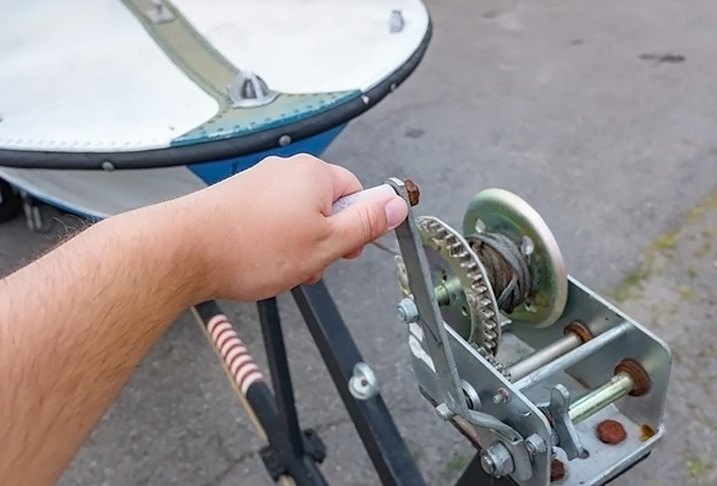
We offer hand crank winches designed for a variety of load ratings in both single-speed and 2-speed gearing configurations. Single speeds are a good choice for light duty trailers and small-to-medium-size boats, while two speed winches are recommended for bigger, heavier boats. It’s important to be aware of your particular boat trailer’s maximum weight capacity before you decide on a winch.
Single Speeds
For best value, the Fulton Single-Speed Trailer Winch (available with or without a 20-foot strap) offers multiple load rating choices up to 1,800 pounds. Should you prefer a modern, slick-looking cover on your single-speed winch, take a look at Fulton’s F2 Series Trailer Winch with 20' Strap.

The JIF Marine 4:1 Ratio Solid Gear Trailer Winch offers single gear configurations of 1,000, 1,200, 1,400, and 1,600 pounds. If space to mount your winch is tight, some configurations offer shorter crank handles.
Moving up a notch, we've got single-speed winches with built-in brake arms which automatically hold a load in position once the handle is released. These are known as "brake winches." For example, the Fulton Brake Winch comes in a choice of 1,000-, 1,500-, and 2,500-pound versions. Or choose Fulton's Deluxe version in 1,000 or 1,500 pound configurations if you prefer heavier-duty construction and larger overall dimensions.
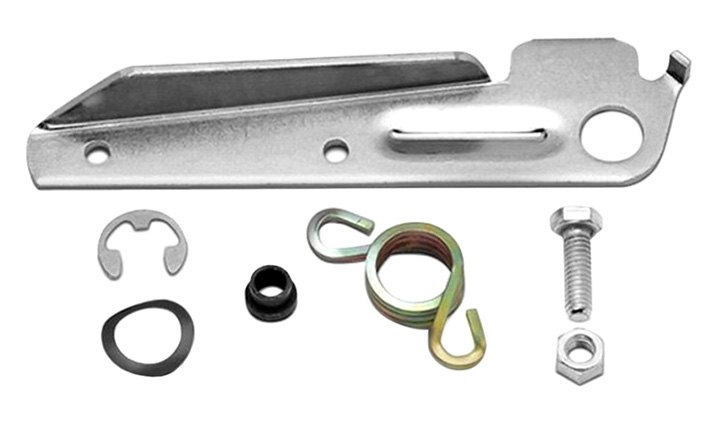
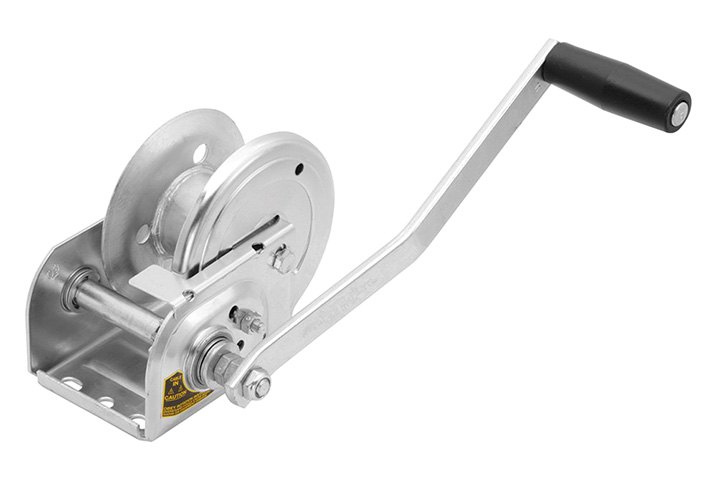
Dual Speeds
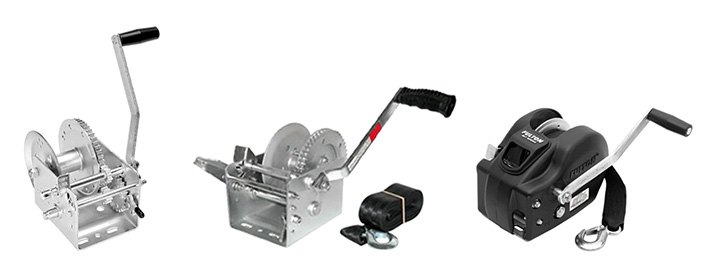
2-speed winches offer both a low gear cam and a high gear cam. Using the low gear requires more cranks of the handle in order to create the additional torque needed to reel in heavier objects. When pulling lower amounts of weight, switch to the high gear to reel the load in faster with fewer cranks. For starters, we've got the JIF Marine 2-Speed Trailer Winch With Strap and Fulton 2-Speed Hand Winch which are available in choices rated up to 3,200 pounds. If you're looking for a 2-speed winch with built-in brake, the Fulton 3200-pound 2-Speed Hand Winch features a 20-foot heavy-duty strap.
Power Winches

For bigger boats and heavier loads, we’ve got power winches that run on 12-volt electrical systems. Usually, these winches are designed to be permanently bolted or welded in place. For example, Fulton offers their XLT Powered Trailer Winch trailer winch in 7,000- and 10,000-pound configurations. We’ve also got the Bulldog Winch 12,000 Pound Trailer Winch available with metal wire rope or synthetic rope.
Portable Power Winches
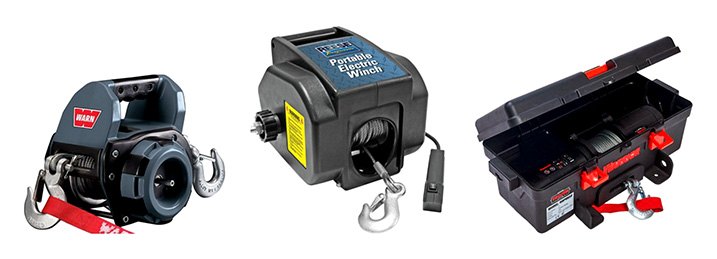
If you prefer the convenience of power operation but would rather not have a permanently anchored winch, we’ve got portable winches ranging from 750 pounds of capacity up to 4,000 pounds. For lightweight boats, the Warn 750 lb Portable Drill Winch is designed to be operated by a standard electric power drill rather than a motor of its own. Warn’s 1,000 lb PullzAll Series Powered Cordless Electric Pulling Tool comes with 2 rechargeable batteries as a power source, and is rated to pull 1,000 pounds.
The Reese Towpower 2,000 lb Portable Electric Winch includes a 20-foot power cable and is rated for 2,000 pounds of straight pulling on dry land, or 5,000 pounds of marine pulling out of the water. The Detail K2 4,000 lb Trojan Series Portable Utility Winch represents the most powerful portable winch we carry, and it comes with two 8-foot heavy duty straps rated for 8,000 pounds, quick connect power cord with alligator clips, and a handheld remote. Should you opt to, the Trojan winch can also be permanently mounted.
Things to Keep an Eye on
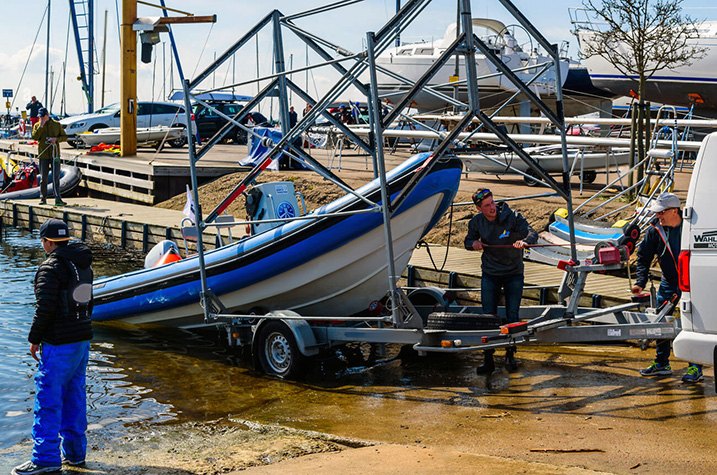
Noone wants to be the person blocking the loading ramp because winch components failed unexpectedly. To ensure your loading and unloading process remains smooth without problems, here are a few things to keep an eye on.
First, make sure the winch you select is protected against corrosion with zinc plated, powder coated, or galvanized components to ensure years of uncompromised use. Corrosion resistance is important whether your boat sees use on a lake or on ocean waters. While winching straps, cables, and ropes are purpose-built for durability and ruggedness, you should check them often for signs of weathering or wear from frequent use. A good winch strap, cable or rope with minimal stretch is one that’s up to its rated pulling capacity. Also check the condition of the hook or attachment hardware.
It's also important to use your winch properly. This means using the right strap, cable, or rope for the size and weight of the boat you are loading, and making sure to position yourself so that the boat is pulled up straight. Pulling at an angle can easily result in damage to the boat, trailer or winch itself. You should also have a solid connection between your boat and the trailer so that no mishaps occur during loading or unloading.
Once a boat is winched into place on the trailer, it must be secured using proper trailer tie down equipment. Relying on a winch to hold your boat in place will create undue stress on the winch itself, and it’s simply not safe.

In addition to the winches covered here, we also offer a selection of individual components such as straps, cables, handles, winch stands, and repair parts from proven brands such as SeaSense, JIF Marine, Boat Buckle, Fulton, Seachoice and Tie Down Engineering. Plus, lots of useful items shown above that you’ll find in our boat trailer parts section.
And when it comes to everything else, we’ve also got the boating items you want and need such as electronics and navigation equipment, must-haves for interior cabin & galley areas, items for on-deck, replacement engine parts and hardware, plumbing-related items, maintenance, and other upgrades to make the boating experience more enjoyable. Whatever you’re looking for, we’re confident you’ll find the right products on the digital shelves of our online store. Visit us at www.BOATiD.com for all your marine needs, or contact our knowledgeable specialists at 888-453-5144.

